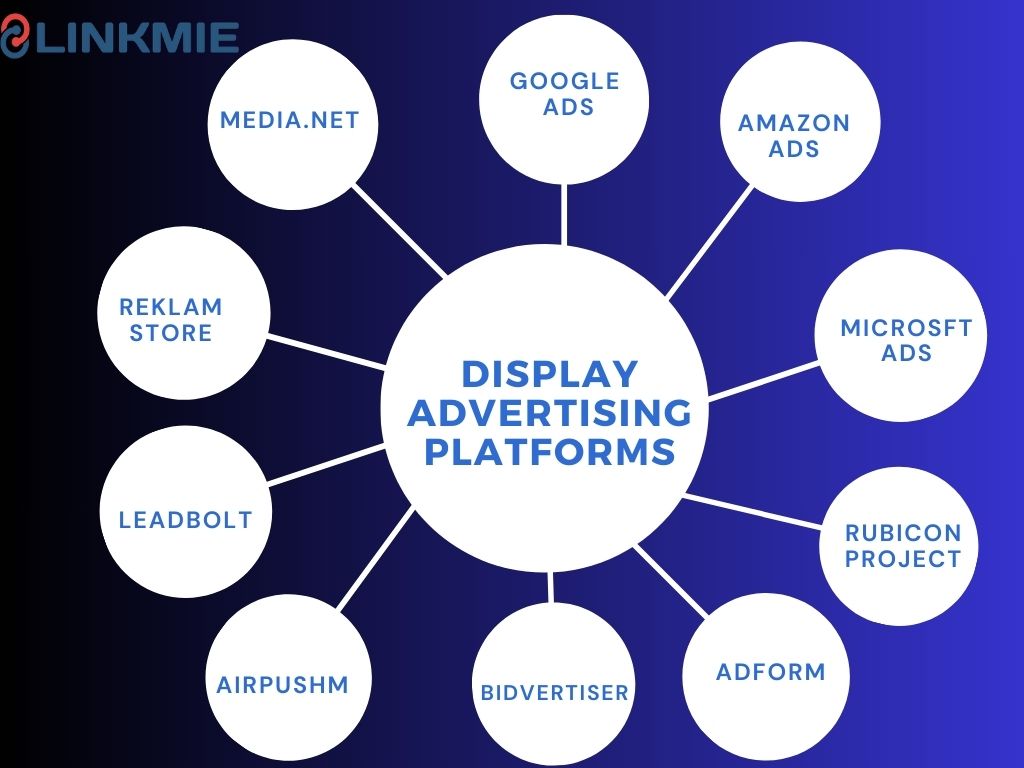In today’s busy online world, it’s more important than ever for businesses to connect with the right people at the right time. Display advertising platforms make this easier by helping businesses show their ads on websites, apps, and social media. These tools let you target your audience with accuracy, whether you’re promoting a product, service, or brand.
When I first started running online campaigns for my business, it didn’t take long for me to realize how essential it was to connect with the right people at the right time. I had some good products, a clear brand message, and the ambition to grow—but without a proper advertising strategy, those products would never reach the people who needed them.
This article will explain what display advertising platforms are, highlight the top 10 options, share their key benefits, and include personal tips along with answers to common questions.
Key Points:
- Display advertising platforms are online tools that help businesses create and manage visual ads, such as banners, videos, and interactive content, on websites, apps, and social media.
- These platforms let businesses target specific groups of people with different types of ads, like images, animated banners, videos, and interactive ads.
- The article talks about 10 top display advertising platforms, including Google Ads, Amazon Ads, Microsoft Ads, Rubicon Project, and others, each offering different benefits.
- To choose the right platform, businesses should understand their audience, set a budget, pick the right type of ad, and make sure the platform fits their goals.
- The benefits of display advertising include reaching a wide audience, showing ads to the right people, raising brand awareness, using different ad formats, and tracking results in real time.
Display Advertising.
Display advertising is a type of online ad that uses pictures, videos, banners, or interactive content to promote a product, service, or brand. These ads show up on websites, apps, or social media platforms, usually through big ad networks like Google Display Network or Facebook Ads.
What are Display Advertising Platforms?
Display advertising platforms are online tools that help businesses create, manage, and improve visual ads like banners, videos, or interactive content. These platforms connect advertisers with websites or apps, making it easier to show ads to the right audience on popular sites.
Unlike search ads that show up on search engine results pages, display ads are more about grabbing attention with visuals. They can come in different formats, such as:
- Static images
- Animated banners
- Video ads
- Interactive ads
Top 10 Display Advertising Platforms.

#1. Google Ads:
I started with Google Ads, and it’s still one of the best options for many businesses. Google Ads helps businesses show up on Google search results, YouTube, and other partner sites. It’s affordable and easy to use, with smart tools like AI to improve ad performance. Features like keyword targeting and audience segmentation make it simple to connect with the right people. If you want more visibility and clear results, this platform is a great choice.
#2. Amazon Ads:
Amazon Ads is perfect for businesses selling on Amazon. It offers three main ad types: Sponsored Products, Sponsored Brands, and Sponsored Displays. Using Amazon’s data, you can target shoppers based on their habits, making it easy to boost your product’s visibility and sales. Plus, its analytics tools help you fine-tune your campaigns for better results.
#3. Microsoft Ads:
Microsoft Ads helps your business show up on Bing search results, Microsoft-owned sites, and partner platforms. It’s easy to use, especially if you’re already running Google Ads since the two can sync. Microsoft Ads gives you access to a different audience, often professional or niche users, making it a valuable tool for your marketing strategy.
#4. Rubicon Project:
Rubicon Project is a platform that helps advertisers and publishers buy and sell ad space quickly and easily. It uses smart algorithms to make sure your ads reach the right people. The real-time bidding system makes the process transparent and efficient, helping you get the most out of your ad budget.
#5. Adform:
This has become one of my favorites for running cross-channel campaigns. Adform is a tool for running ads across multiple channels like websites, mobile apps, and connected TVs. It helps businesses keep their branding consistent everywhere. Its reporting tools give you helpful insights so you can make better decisions and improve your campaigns.
#6. Bidvertiser:
Bidvertiser is a simple ad network offering formats like banners, pop-ups, and sliders. It focuses on sending targeted traffic to your site, which leads to better engagement. With competitive pricing and an easy-to-use system, it’s great for businesses of any size.
#7. Airpush:
Airpush focuses on mobile advertising, reaching users through over 150,000 apps. It uses in-app ads, video ads, and push notifications, all based on user opt-ins. This means users are more likely to interact with the ads, making it an effective option for mobile campaigns.
#8. Leadbolt:
Leadbolt is another mobile ad platform, offering flexible options for campaign management. You can choose a hands-on or hands-off approach. Its real-time bidding feature helps you get the most value for your budget. Designed for mobile users, Leadbolt ensures your ads connect with people on the go.
#9. ReklamStore:
ReklamStore is an online advertising platform that helps businesses boost their visibility and reach more people. I came across ReklamStore while looking for an all-in-one advertising solution. It offers different tools for promoting products, like targeted display ads, search engine marketing, and social media ads. The platform uses smart technology and user data to help businesses connect with the right audience. ReklamStore has an easy-to-use interface, so users can quickly create, manage, and track their ads. With customizable options and clear results, ReklamStore is ideal for businesses of all sizes, helping them meet their marketing goals and get a better return on investment (ROI).
#10. Media.Net:
Media.Net is a global advertising company that helps connect advertisers with website owners. It provides a way for publishers to display ads that match the content on their pages, offering an alternative to Google AdSense. The platform uses smart technology to show ads that are relevant to what visitors are reading, making the ads more engaging. Media.Net uses advanced algorithms to match the right ads with the right websites, helping website owners earn more money. The platform supports different types of ads, including display, native, and mobile ads, and provides detailed analytics to track how well ads are performing. Media.Net is known for working with top-quality advertisers, ensuring that website owners get high-quality ads.
Steps on Choosing the Best Display Advertising Platforms for Effective Campaigns.
#1. Know Your Audience:
Start by figuring out who you want to reach. Look into their age, interests, and habits. Knowing your audience helps you pick the platforms they use the most.
#2. Set Your Budget:
Decide how much you’re willing to spend on the campaign. Your budget will influence which platforms you can afford, as some cost more than others.
#3. Set Your Goals:
Figure out what you want to achieve—whether it’s getting more brand awareness, generating leads, or making sales. Having clear goals will guide your choice of platforms and help you measure success.
#4. Pick Your Ad Type:
Decide which type of ad fits your campaign—banner ads, video ads, or native ads. Some platforms may only support certain types of ads, so this helps narrow down your choices.
#5. Think About Reach:
Look at how many people you can reach on each platform. A bigger reach could mean more conversions, but make sure it fits within your budget.
#6. Stay True to Your Brand:
Choose platforms that match your brand’s voice and values. Ads should feel natural and authentic to the platform, helping you build trust with your audience.
#7. Make Your Ads Stand Out:
Create eye-catching visuals that fit your message. Great visuals grab attention, especially on crowded platforms.
#8. Refine Your Audience:
Go back to your audience research and get more specific about their needs and behaviors. The more detailed your targeting, the better your ads will perform.
#9. Review Your Goals Again:
Check your goals to make sure they’re clear and measurable. This helps you choose platforms that will help you track and meet those goals.
#10. Consider Other Factors:
Think about things like where your ads will appear, current trends, and past campaign performance. These factors can help you decide which platforms and how to spend your budget.
#11. Pick the Right Platforms:
Based on your audience, budget, and goals, choose the platforms that fit best. Popular choices include Google Display Network, Facebook, Instagram, LinkedIn, and programmatic networks.
#12. Test and Improve:
After your ads are live, track how they’re performing and try out different versions. Use the data to adjust and improve your campaigns.
#13. Know Ad Sizes:
Make sure your ads are the right size for each platform, as they all have different requirements. The right size helps your ads look good and get noticed.
#14. Use Different Visuals:
Create a variety of images, videos, and graphics to keep your ads fresh. Using different visuals allows you to test what works best and keep your audience engaged.
By following these steps, you can make sure your ads reach the right people in the right way, giving you the best chance for success.
To help you keep track of your campaigns, here is a KPI Tracker template to use as a guide in monitoring your campaigns.
Benefits of Display Advertising Platforms.
Using display advertising platforms offers several key benefits that can help businesses meet their marketing goals more effectively.
#1. Reach a Wide Audience:
Platforms like Google Display Network or social media networks help your ads reach a large and diverse audience across websites, apps, and devices. This helps increase your brand’s visibility to potential customers.
#2. Target the Right People:
Display advertising allows you to target specific groups based on factors like age, location, interests, and behavior. This ensures that your ads are shown to people who are more likely to be interested in your product, making your ad spending more efficient.
#3. Affordable Advertising:
Display ads can be more cost-effective than traditional advertising. You can set your own budget and choose pricing models like cost per impression (CPM) or cost per click (CPC), giving you more control over your expenses. Many platforms also offer bidding strategies to help you get the best value for your budget.
#4. Increase Brand Awareness:
Display ads are great for building recognition for your brand. Their visual nature helps highlight your brand’s logo, colors, and messages in a way that’s hard to ignore, making it easier for consumers to remember you when they’re ready to buy.
#5. Remarketing Opportunities:
These platforms let you target users who have already visited your website or interacted with your brand, bringing them back to complete a purchase or action, which can help boost conversion rates.
#6. Engage with Visuals:
Display ads allow you to use creative visuals like images, videos, and interactive elements, making it easier to catch people’s attention and communicate your message in a more engaging way, especially in busy online spaces.
#7. Flexible Ad Options:
There are different ad formats to choose from, such as static images, animated banners, and videos. This lets you try out various approaches and see what works best for your audience.
#8. Track Your Results in Real-Time:
Most display advertising platforms offer detailed analytics so you can track how well your ads are performing in real time. You can see key metrics like impressions, clicks, conversions, and return on investment (ROI), helping you improve your campaigns.
#9. Cross-Platform Reach:
Many platforms, like Google and Facebook, let you run ads across desktops, smartphones, and tablets, ensuring that your brand message reaches people no matter what device they’re using.
#10. Easy to Manage:
Display ad platforms are often easy to use, allowing you to create, manage, and improve your campaigns quickly. You can test different ads, adjust your target audience, and shift your budget to the best-performing strategies.
#11. Better Engagement:
Because display ads are visually appealing, they tend to get more interaction than text-based ads. Features like clickable banners and videos encourage users to engage with your brand.
#12. Increase Conversions:
When paired with targeted messaging and eye-catching visuals, display ads can guide users through the buying process and boost conversions. Remarketing also helps persuade people to complete their purchase or take the next step.
#13. Stay Ahead of Competitors:
Since display ads are flexible and accessible, they can give your brand an edge by increasing your visibility and ensuring your ads appear on various platforms and websites.
Conclusion.
Display advertising platforms help businesses connect with their audience, increase brand visibility, and boost conversions. By choosing the right platform and managing campaigns well, businesses can effectively reach their target audience and get the most out of their advertising budget. With many platforms and ad formats available, businesses can customize their campaigns to meet their specific needs.
Frequently Asked Questions.
What are display advertising platforms?
Display advertising platforms are tools that allow businesses to create and manage visual ads across websites, apps, and social media, helping them reach and engage their target audience.
Which is the best display advertising platform?
The best platform depends on your goals and audience. Popular options include Google Ads, Amazon Ads, and Microsoft Ads, each offering unique features for different needs.
How can display ads improve brand visibility?
Display ads use visuals to grab attention, making it easier for people to remember your brand. Platforms like Google Display Network and social media help you reach a large audience, boosting visibility.
How do I choose the right platform for my ads?
Know your audience, set a budget, and define your goals. Then choose a platform that meets your needs. Popular platforms include Google, Facebook, and Instagram.
Can display ads target specific groups?
Yes, many platforms allow you to target users based on factors like age, location, interests, and behaviors, ensuring your ads reach the right people.
What is remarketing in display advertising?
Remarketing targets users who have interacted with your brand or visited your site before, encouraging them to take further actions, like making a purchase.
Are display ads suitable for mobile campaigns?
Yes, platforms like Airpush and Leadbolt specialize in mobile ads, providing ads designed for mobile devices and apps to reach users on the go.
Related Articles
- How to Choose the Right Advertising Platform for Your Brand
- Maximizing Your Guest Posting Strategy with Guest Posting Platforms
- Top 10 Programmatic Advertising Platforms for Maximum ROI
- What Are CTV Advertising Platforms? An Introductory Guide






